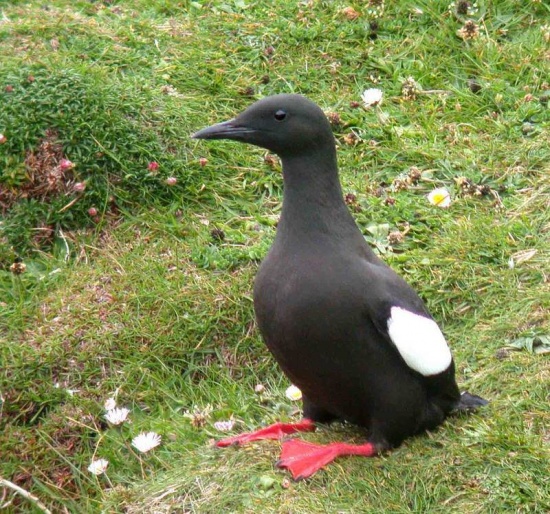Nomdeploom (talk | contribs) (Add taxonomy, reorganize some info to more std. template, add to description) |
Nomdeploom (talk | contribs) m |
||
| Line 9: | Line 9: | ||
Subspecies: Five races occur in the region but separation at sea is rarely possible. Most distinctive is ''mandtii'' from Jan Mayen, Bear Is. and Svalbard, with whiter upperparts in non-breeding plumage. Remaining races, nominate ''grylle'' from the Baltic, ''arcticus'' from British Is. to Arctic Russia, ''faroeensis'' from Faroes and ''islandicus'' from Iceland are all very similar, differing only in minor measurements. | Subspecies: Five races occur in the region but separation at sea is rarely possible. Most distinctive is ''mandtii'' from Jan Mayen, Bear Is. and Svalbard, with whiter upperparts in non-breeding plumage. Remaining races, nominate ''grylle'' from the Baltic, ''arcticus'' from British Is. to Arctic Russia, ''faroeensis'' from Faroes and ''islandicus'' from Iceland are all very similar, differing only in minor measurements. | ||
| − | == | + | ==Distribution== |
Breeds in Iceland and the Faroes, Jan Mayen, Bear Island, Svalbard and Franz Josef Land, north and west British Isles, around the north coasts of the Baltic and islands in the Kattegat, coastal Norway to the Murmansk Coast and the White Sea, and on Kolguyev and Novaya Zemlya. Most populations are resident with little or no movement away from breeding sites but in the far north most birds move southwards. Birds from Finland and Gulf of Bothnia winter mainly off south-east Sweden. Occasionally seen south of main range in winter, annually recorded in Netherlands, more rarely south to northern France and Belgium and exceptionally recorded in Czechoslovakia and Yugoslavia. Recently recorded off Spain. They are also found in Eastern North America as well. | Breeds in Iceland and the Faroes, Jan Mayen, Bear Island, Svalbard and Franz Josef Land, north and west British Isles, around the north coasts of the Baltic and islands in the Kattegat, coastal Norway to the Murmansk Coast and the White Sea, and on Kolguyev and Novaya Zemlya. Most populations are resident with little or no movement away from breeding sites but in the far north most birds move southwards. Birds from Finland and Gulf of Bothnia winter mainly off south-east Sweden. Occasionally seen south of main range in winter, annually recorded in Netherlands, more rarely south to northern France and Belgium and exceptionally recorded in Czechoslovakia and Yugoslavia. Recently recorded off Spain. They are also found in Eastern North America as well. | ||
Revision as of 19:30, 10 November 2007
- Cepphus grylle
Description
Chunky, round-winged seabird found close to rocky ocean shores. Adults are all black except for while upperwing coverlets. Bright red legs and gape. Length 33cm, WS 53cm, wt. 430gm. Appearance, voice, and behavior almost identical to Pigeon Guillemot.
Taxonomy
Kingdom: Animalia -> Phylum: Chordata -> Class: Aves -> Order: Charadriiformes-> Family: Alcidae-> Genus: Cepphus -> Species: C. grylle
Subspecies: Five races occur in the region but separation at sea is rarely possible. Most distinctive is mandtii from Jan Mayen, Bear Is. and Svalbard, with whiter upperparts in non-breeding plumage. Remaining races, nominate grylle from the Baltic, arcticus from British Is. to Arctic Russia, faroeensis from Faroes and islandicus from Iceland are all very similar, differing only in minor measurements.
Distribution
Breeds in Iceland and the Faroes, Jan Mayen, Bear Island, Svalbard and Franz Josef Land, north and west British Isles, around the north coasts of the Baltic and islands in the Kattegat, coastal Norway to the Murmansk Coast and the White Sea, and on Kolguyev and Novaya Zemlya. Most populations are resident with little or no movement away from breeding sites but in the far north most birds move southwards. Birds from Finland and Gulf of Bothnia winter mainly off south-east Sweden. Occasionally seen south of main range in winter, annually recorded in Netherlands, more rarely south to northern France and Belgium and exceptionally recorded in Czechoslovakia and Yugoslavia. Recently recorded off Spain. They are also found in Eastern North America as well.
Habitat
Colonial breeder in boulder piles at the base of cliffs and on scree-covered slopes on low rocky islands and coasts. Winters mainly in sheltered bays close to breeding site.
Bird Song
<flashmp3>Cepphus grylle (song).mp3</flashmp3>
Listen in an external program




